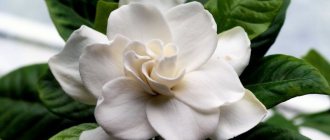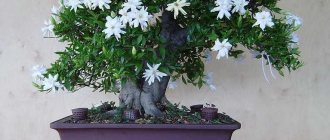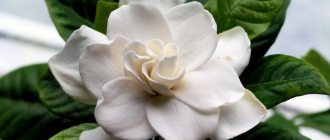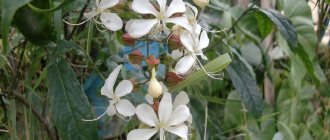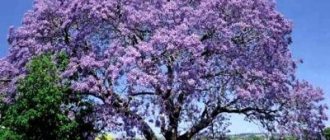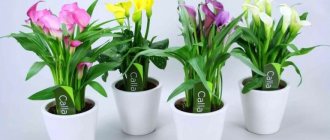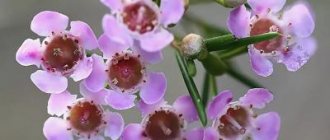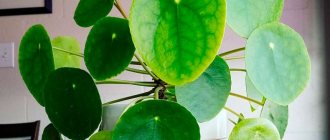This fragrant tropical flower has a not very good reputation as a capricious and difficult plant to grow at home. Gardenia is really not easy to plant and care for, and a small inaccuracy in agricultural technology can easily negate all the efforts expended. However, if you approach the issue and select a variety wisely, you can significantly simplify this task and achieve your goal. And considering the exquisite appearance and stunning jasmine aroma of the flower, which has long been valued and used in the manufacture of cosmetics and perfumes, it is worth it. And, of course, it is also important to learn “on the shore” how to care for the capricious gardenia at home and achieve its favor.
general description
In the wild, gardenia is an evergreen shrub that can sometimes take a tree-like form. Belongs to the Marenov family. It grows in tropical and subtropical forests of China, India, Indonesia, and is found in Japan. It is a compact bush with a smooth stem and short branches with leathery, shiny leaves of rich green color.
Flowering is long-lasting, beginning in mid-summer and ending in October. With proper planting and proper care during this period, its shoots are completely strewn with numerous flowers in varying degrees of budding. Outwardly, they are similar to roses; they are not inferior to the queen of flowers in terms of their delicate, pleasant aroma. The elegance of appearance allows gardenia to be used in interior design of a wide variety of styles.
The closest relative of this tropical flower is coffee.
Trimming
Pruning gardenia jasmine at home is of great importance for the successful maintenance and care of the plant. The process is used not only for the purpose of sanitary rules for removing diseased or dried parts, but also after each flowering to ensure proper growth of the flower and maintain a decorative appearance. Weak, yellowed, withered parts should be removed without delay.
Types of gardenia with photos
Botanists describe about 250 varieties, among which the most suitable for home cultivation is jasmine gardenia (Gardenia jasminoides), native to the southern provinces of China. The second, almost unused name of the variety is Gardenia Augusta. Its double inflorescences resemble camellia. They are also trying to grow the African variety of gardenia thunbergia (Gardenia thunbergia), which is distinguished by single inflorescences, at home. You should know that the second variety is more whimsical. In addition, knowledge of how to care for gardenia is not enough without meeting a number of subjective conditions (for example, the absence of windows of the desired orientation or their shading by trees).
As a result of long cultivation of the jasmine variety, many varieties have appeared, of which the most popular and suitable for growing in rooms and greenhouses can be identified.
- Beauty is a tall variety with large double waxy flowers that bloom throughout the summer season and until the last days of October. In greenhouses it can reach 2 meters in height.
- Chuck Hkys is a semi-double, very fragrant variety with ivory-colored flowers. Summer flowering, quite short. It is characterized by increased resistance to cold.
- Amy - stands out for its lighter foliage color. The flowers are double and have an almost ideal shape, which makes them look like artificial ones. Highly valued for its ability to bloom twice a year.
- Mystery is a tall, large-flowered variety with very dark-colored leaves. Terry inflorescences have a flat shape, up to 13 cm in diameter. Forms a very strong bush with a tendency to grow vertically. It can also bloom a second time.
- Belmond is large-flowered and densely doubled, has a high tolerance to low temperatures and diseases. The diameter of the inflorescences with a stunning aroma reaches 10 cm.
- Variegata is a slow-growing compact shrub with rounded, variegated leaves that range from green to light beige. A good option for pot growing at home.
- Radicans is a dwarf variety that is ideal for bonsai. The width of the crown exceeds its height. The leaves are small, leathery, with a waxy sheen, the flowers are double and medium-sized. Flowering occurs later than other varieties of jasmine gardenia.
- Radican Variegata is a variety bred on the basis of the previous one with more developed characteristics. Growing extremely slowly, making it an excellent candidate for bonsai, the green leaves have a light cream stripe along the edge. Flowering is late, short, in summer.
- Golden Magic - the white corollas of the inflorescences have a characteristic transition to a golden yellow color. Blooms spectacularly and for a long time.
3.Varieties:
3.1. Jasminoid or regal gardenia - Gardenia Jasminoides
An evergreen shrub from 1.5 to 2 m high with abundantly branching, erect stems. The leaves are dark green, up to 10 cm long, thick, glossy, entire, lanceolate. The leaf blades are covered with a network of branched veins. Leaf petioles are short. The flowers are large - reaching a diameter of 8 cm, reminiscent of a rose, and emit a very intense aroma reminiscent of jasmine. Flowering occurs from May to July.
↑ Up,
3.2.Tahitian gardenia - Gardenia taitensis
Tall multi-stemmed shrub, reaching 4 meters in height. The leaves are lanceolate, entire, dark green, arranged in opposite pairs. The leaves reach 15 - 16 cm in length. Leaf veins are often highlighted in a lighter shade. The shoots are thin, flexible, abundantly branched. The flowers are light - white or cream, up to 9 cm in diameter, and have a sweetish aroma.
↑ Up,
3.3.Vietnamese gardenia - Gardenia vietnamensis
Fast-growing, evergreen, multi-stemmed shrubs with thin shoots up to 1 m high. The leaves are oblong, lanceolate, dark green, entire. The flowers are cream-colored, solitary, with narrow, long petals, and have a sweetish aroma that intensifies in the evening and night hours.
↑ Up,
3.4.Gardenia Thunberg - Gardenia thunbergia
Multi-stemmed, dense, evergreen, large-flowered shrub or small flowering tree, height from 1.5 to 4.5 m. Leaves are oblong - oval, lanceolate, glossy, dark green, collected in whorls of 3 - 4. Flowers are showy, cream, large reach a diameter of 8 cm. During the flowering period, the shrub emits a pleasant aroma, which is especially intensified at night and in the evening.
↑ Up,
Features of purchasing gardenia
Despite the increased demands of the flower for warmth, it is currently possible to buy it all year round, although this is certainly more difficult to do in winter. The copies sold have a clear division into “classes” according to the category of their cost among manufacturers. The most expensive specimens are offered for sale in the bud stage, which requires help to open. This should be done under a warm, but not hot shower.
Moving a gardenia into a house (or any other place) is much more stressful for it than for many other plants, so many specimens die at this stage. According to flower growers, drugs such as Epin, Zircon or HB101 can help her survive stress. The dosage and frequency must be followed according to the attached instructions.
In expensive specimens, the inner petals are often carefully sealed with wax, which requires the same careful removal. The buds may have supporting collars of leaves on top. Cheaper varieties (or producers) usually have smaller and more open buds, and they often have plastic collars on them.
When buying a gardenia as a gift, you should think very carefully about whether the recipient can handle this flower and provide it with the care it needs. Otherwise, the gift will only leave you disappointed.
Caring for gardenia indoors
Each point of the requirements for agricultural technology is important in this case and requires strict implementation.
Lighting
The flower loves full light throughout the day, but does not react well to direct midday rays. The ideal location would be a very bright but not hot location on a window facing west or southwest, with thin tracing paper pasted on it to protect from direct sun at midday. In winter, the tracing paper can be removed. The window should not be shaded by trees growing behind it.
Gardenia is extremely sensitive not only to the intensity of light, but also to its direction. During the period of budding and flowering, it can not only be moved to another place, but even rotated relative to the light source. The buds may fall off.
Temperature
A flower's love for warmth does not mean that it needs to be kept in a hot room. There is a certain range of comfort, which directly depends on the time of year and the stage of vegetative development. In the spring-summer period, the optimal temperature lies within +20...+24C. In winter it should be gradually reduced by 4-5C relative to summer. The minimum temperature threshold is +16C. During the period of bud formation it rises to +18…+20С. Whatever the layout, the roots should never be in cold soil (colder than the air in the room). Sharp fluctuations in temperature readings are especially dangerous for crops. In winter, the plant experiences a lack of light, and cooler conditions can partly compensate for this.
Gardenia categorically does not tolerate drafts, reacting to them by shedding buds and buds. It is better to ventilate the room using forced ventilation directed in the other direction.
Air humidity
High and uniform air humidity is one of the conditions for the successful development and flowering of a plant. It places especially high demands on humidity during the period of bud formation. In dry air, the process may stop developing, and the buds that have begun to form may fall off. A tray filled with sphagnum moss or moistened expanded clay will help solve the problem, but the flower pot itself should not touch the bottom. Regular spraying of foliage is recommended, however, water should not get on flowers or unopened buds (unsightly spots may appear).
Watering
For irrigation, you should use warm and soft water, preferably settled, boiled or filtered. In summer, watering should be constant to keep the soil moderately moist. Overfilling is highly undesirable. The plant loves a warm shower, but at this time you need to close the earthen ball. In the winter season, watering is reduced to moderate, but the earthen ball should never be overdried.
Top dressing
Additional nutrition should be provided during the period of active growing and flowering, in spring and summer (1-2 times monthly). Use liquid complex fertilizers for flowering crops, but at half the dosage recommended in the instructions.
Trimming
The crop not only tolerates pruning well, but also needs it periodically. Trim the shoots after flowering ends, leaving half or a third of them. During the period of active growth, you can pinch the tops of non-flowering shoots to stimulate the growth of new ones.
Cut parts of the stems can be used as apical cuttings for propagation.
Plant diseases
It is not always possible to recreate completely comfortable conditions for indoor flowers, which is why they periodically acquire a number of diseases. And since gardenia is capricious, a small jump in temperature may be enough to make it sick. In order to provide assistance, it is necessary to study the symptoms of each disease in a timely manner.
The buds are falling
There may be several reasons why unopened gardenia flowers fall off:
- Dry microclimate.
- Incorrect ventilation of the room, resulting in drafts.
- Stress from temperature fluctuations.
- Replanting a plant during flowering.
- Transporting the pot to another place.
Yellow stains on leaves
There may also be several prerequisites for a gardenia to change its color:
- Incorrect watering. Some inexperienced gardeners, relying on the preferences of a capricious plant, over-moisten the soil. It is worth considering that the substrate should not be flooded, but only slightly moistened. Also, a mistake can be made in the quality of the water; it should not be hard and cold.
- Unsuitable soil.
- Bad light.
- Insufficient amount of fertilizing.
Weak flowering
In the case of modest flowering or its absence at all, the causes of the disease are similar to those in which the gardenia drops its buds. True, in this case they can also be supplemented by oversaturation of the soil with alkalis.
Faded leaves
Discolored foliage is a symptom characteristic of chlorosis. This disease can be considered chronic for an exotic bush. The disease is caused by a lack of iron compounds in the soil. To maintain vital activity, gardenia should be treated with Ferovit or any other preparation containing iron.
This is interesting: as a preventative measure, you can stick one or more rusty nails into the soil.
Slow growth
Stopping development is a strong argument for a thorough inspection of the plant. Probably, the gardenia is susceptible to insect activity or the microclimate is not arranged correctly. If pests are detected, immediate action should be taken. But it would be useful to reconsider the growing conditions. High humidity coupled with low temperatures has a negative impact on the crop.
Not everyone can take care of exotic gardenia, however, if you do it correctly, there will always be harmony and a magnificent jasmine aroma in your home.
What kind of soil does gardenia need?
Calcareous and alkaline soils are not suitable for it; high acidity levels from pH = 5 and slightly higher are needed. When replanting gardenia after purchase, you should try to preserve its soil lump as much as possible; for adding to it, it is recommended to buy a ready-made substrate for azaleas. It’s best not to experiment with making your own soil mixture to begin with. For later transplants, you can add a composition of equal parts of three types of soil (coniferous, turf, leaf) and quartz sand.
Feeding and fertilizer
What soil is needed for gardenia jasmine? Capricious gardenia requires special selection of soil with a slightly acidic pH level. If there are lime components in the composition, it dies.
To prepare the soil yourself, you should stock up on the necessary elements and patience. If you are not confident in achieving your goal, it is better not to experiment; the flower will begin to fade and in an attempt to save money, you can destroy the plant.
The soil composition includes:
- sand component;
- turf part;
- coniferous peat land;
- rotten leaf soil.
As for periodic fertilizing of the soil for gardenia jasmine, it is better to use liquid types of fertilizers, adding 1-2 times a week when watering. Properly selected mineral fertilizer for gardenia jasmine not only improves health, but also preserves the growth, flowering, and development of an evergreen flower.
Planned transplant
The frequency of planned transplantation is usually two years. The new container should be 2 cm wider than the previous one. In order to replant the gardenia painlessly and correctly, you need to handle its root system as carefully as possible, preserving the earthen lump. This is done in early spring before the start of active growing season and the release of buds. During flowering, replanting is categorically not recommended and can only be justified by the threat of death. The flower will not only shed its buds, but may also die. Good drainage must be provided!
We change our place of residence
Gardenias need to be replanted following certain rules:
- take your time, let the plant adapt to new conditions;
- choose a more spacious pot;
- move along with a lump of earth so as not to disturb the roots;
- Place a drainage layer of small stones and expanded clay on the bottom of the pot;
- water the ground with warm water and compact it;
- if the plant is old, inspect the roots, remove damaged areas, disinfect with a weak solution of potassium permanganate;
- After transplanting, water it with warm filtered water and place it in a permanent habitat.
Attention! Gardenias should not be disturbed while the flowers are preparing to bloom. The plant will better tolerate transplantation when it has finished flowering.
Reproduction
As a result of planned pruning, excellent material remains for vegetative propagation - apical cuttings. They should be about 10 cm long. For their rooting, use a warm nutrient substrate (see above) and any root formation stimulator. Setting up a mini-greenhouse using a jar or transparent bag will speed up the process. It is acceptable to keep the cuttings in water, but in this case they may not produce roots. After the cutting has doubled in height, it is pinched. You need to be prepared for the fact that the process will be lengthy and not always successful.
How does it reproduce
Gardenia jasmine reproduces in three ways:
- vegetative;
- seed;
- air layering.
Germination of seeds
Since the seeds lose their similarity very quickly, immediately after ripening they are cleaned and soaked for a day in water, only after which they can be sown. Sowing is done no more than five millimeters.
For successful seedlings when propagated by seeds, the following conditions must be met:
- prepare a mixture of leaf and pine compost and perlite;
- temperature – not lower than 23 degrees;
- seeds germinate only after four months;
- It is recommended to plant sprouts that have sprouted until two leaves appear in separate pots.
Rooting cuttings
The plant can also be propagated by cuttings. For this method, you should cut a stalk ten centimeters long. The cut site is treated with a stimulator to form roots. For successful germination, the following conditions must be met:
Gardenias are replanted every two years.
- the air temperature must be at least 24 degrees;
- for better rooting, it is recommended to create partial shade for the cuttings;
- high humidity is welcome;
- ventilation is required;
- the soil should be slightly moist;
- the rooting mixture consists of sphagnum moss and perlite;
- Rooting period is from one to two months.
Air layering
For this method, you will need to clear at least ten centimeters of leaves from a long section. A notch is made under the leaf bud in the middle of the pagon, which must be treated with hot water and a stimulant for root formation. The incision site is wrapped with sphagnum moss, then with plastic wrap. As soon as the roots appear, the shoot is cut off and planted in the ground.
Possible problems
- Very slow development, lack of flowering, pale foliage. The flower lacks nutrition and light.
- Gardenia leaves turn yellow or become covered with yellow spots. There is not enough soil acidity, the soil needs to be acidified.
- The flower droops, loses its buds, and the leaves become limp. It is necessary to check the temperature; most likely, it is below normal.
- Leaves fall, sometimes remaining green. Cold irrigation water, lack of moisture.
- The gardenia is drying up. Various unfavorable factors may occur, the most common being dry air and lack of moisture.
- Reset of buds and flowers. Drafts or moving the pot from place to place, sudden changes in lighting intensity.
